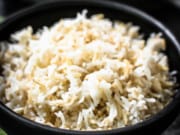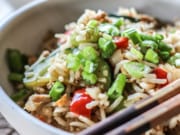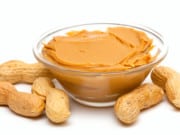The debate over genetically modified foods (GMO’s) is one with fervent viewpoints and opinions on both sides. We humans love us some controversy, and the debate over whether or not we should be genetically modifying our food is one that rages today and will into the future. In the last election, a bill in California to require the labeling of GMO foods was rejected (somewhat surprisingly given California’s culture). On one side, you have people that think that genetically modifying food is unnatural, capitalist profit-driven, and prone to errors and health problems for those who eat the GMO food. But on the other side is golden rice.
Golden rice is rice that’s been genetically modified to produce beta-carotene, a precursor to vitamin A production in the body. The beta-carotene literally turns the rice a golden color instead of the normal white. In normal rice, the endosperm (the edible and most commonly eaten part) contains no beta-carotene. Vitamin A is an essential and diversified nutrient for the human body, being involved in vision, immune function, gene transcription (growth and development), skin health, and antioxidant activity just to name a few. A deficiency can result in a multitude of serious health problems and can, and does, lead to death. In fact, tens of millions of people in underdeveloped parts of Asia and Africa don’t get enough vitamin A from their diet. Its deficiency literally accounts for millions and millions of deaths and serious, irreversible health problems. When you take into account that rice is a major food staple for many of these same people suffering from vitamin A deficiency, you arrive at the crux of the controversy. If simply planting and proliferating golden rice could literally save countless numbers of lives and improve the lives of countless others, then you get an idea of the incredible impact golden rice could have.
One bowl of golden rice can supply 60% of a child’s daily vitamin A needs. Often in these impoverished countries, children are weened off of breast milk using a sort of rice gruel. Since normal rice lacks vitamin A, these children are not getting the nutrition they need at such a young age to grow and develop properly both mentally and physically. Golden rice has the potential to solve all that. But there is still fierce controversy on both sides. Proponents argue that golden rice could and does save countless lives and prevents countless numbers of vitamin A-related deficiency syndromes. It has been proven to be a bioavailable (able to be utilized effectively by the human body) form of vitamin A. Somewhat similar practices such as fortifying breakfast cereals and breads with nutrients like folic acid, adding iodine to salt, and adding fluoride to drinking water have been effective at preventing deficiencies. Proponents may also argue that selectively breeding plants and animals (which is already a widespread global practice) is in itself a type of genetic modification, or at least human manipulation of food. Opponents, of which Greenpeace is one, would argue that it isn’t a long term solution and that improving traditional farming practices, utilizing supplementation, and trying to make other sources of vitamin A more available to impoverished people would be better. Opponents also point to possible profit-driven motives by golden rice proprietors and distributors and see it as another way in which farming is becoming overly corporatized. They also see golden rice as a potential doorway to other GMO foods being accepted and utilized all across the world.
Both sides certainly have valid arguments, and when millions of lives are at stake, it is easy to see why the subject is so controversial. On one hand, making golden rice widely available to impoverished nations could effectively combat vitamin A deficiency and the millions of deaths and health complications that follow. If you are living gluten-free, look at it from this perspective: what if scientists found a way to genetically modify wheat that removed the gluten? How would you feel about that? Would you add that special gluten-free wheat back to your diet? On the other hand though, perhaps golden rice is missing the point, and we should focus on improving the diet and poverty that lead to vitamin A deficiency in the first place. And maybe golden rice is simply unnatural and the whole idea of genetically modified food gives you the willies. Only you can decide which side of fence to sit on and let your voice and vote be heard in the future when the issue of GMO food is at stake.
Article Courtesy: Andrew Steingrube







Let Us Know What You Think